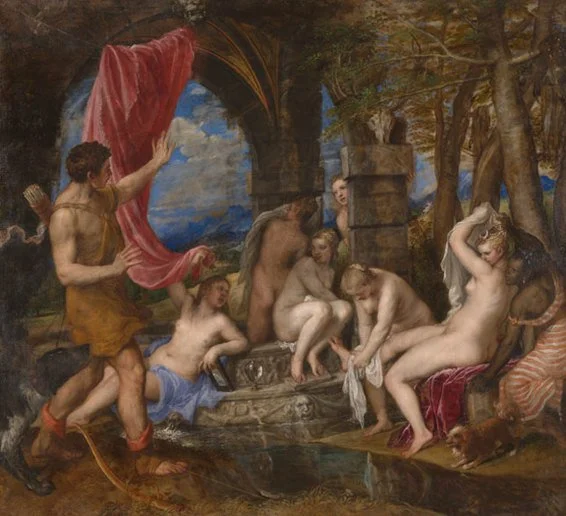The Sutherland Family and Titian
George Granville Leveson Gower (later 1st Duke of Sutherland) was part of a consortium that bought the Duc d’Orleans art collection following the French revolution. Gower probably provided the impetus for the deal as he was Britain’s ambassador to France in the early 1790s. Two pictures by Titian ‘Diana and Actaeon’ and ‘Diana and Callisto’ were among the works purchased and these works eventually came down through the family by inheritance before being purchased jointly by the National Gallery and National Galleries of Scotland in 2012.
The acquisition of these paintings by the landed consortium, of which Gower was part, was different in nature from the contemporary art that they were commissioning from artists such as Gainsborough or Romney. These contemporary works were commissioned to celebrate and commemorate the patron and their family, their achievements, learning, acts, deeds, and power.
Purchasing the paintings by Titian, which were already renowned at this date, was the act of wealthy, collector-connoisseurs. It was also a shrewd business move. What interests me, in relation to the Sutherland family’s ownership of these pictures, is what these paintings depict.
Firstly, they show scenes from Ovid’s Metamorphoses. Classical subjects had been popular in Western art since the renaissance but interest in the mythology, architecture and art of ancient Greece and Rome had reached fever-pitch during the neo-classical period which still dominated at the time of the consortium’s purchase from Duc d’Orleans. Patrons often chose to have themselves painted in the guise of Greek Gods or nymphs, whilst allusions to classicism also abound in the props employed in the stock portraiture of the late eighteenth century. Thus, as well as being renowned works by a master, the subject of the two Titian’s was fashionable and spoke of the paintings’ owners sophistication and taste.
Secondly, both stories alluded to to by Titian recall the unfettered power of the omnipotent classical deities. An power which was similar to that enjoyed by the Sutherland - Gower family in Britain at the time. For instance, ‘Diana and Actaeon’ tells the story of a huntsman who was turned into a deer and torn limb from limb by his own hounds as punishment for witnessing Diana naked. In Sutherland in 1811 the sheriff-depute of the county, Robert Mackid, was caught poaching by the estate Factor, Patrick Sellar. Sellar humiliated Mackid, who in turn swore revenge upon Sellar. Sellar was the subject of a botched culpable homicide trial after which Mackid was forced to resign from his deputy-sheriffship, give up his farm, and leave Sutherland.
Other parallels between the tales of Ovid and Highland society and the power of the landowning classes.
